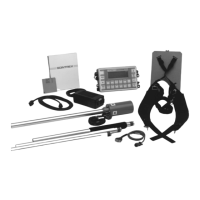Applications
B3-4 ENVI-MAG Manual
These survey stations will serve as reference points to locate your data points on
the survey grid and eventually to locate data points on a scaled map of your data.
This map will in turn be used for your interpretation of the data.
As illustrated in (Figure B-20), survey lines and stations are usually labelled in the
manner NN D, where NN represents the major digits of the distance and D
represents the direction of the line. For example, a typical environmental grid
with survey lines oriented in a north-south directions located every metre and
with marked stations every 10 metres would have survey lines labelled 1E, 2E, 3E,
etc. and stations along these survey lines labelled 10N, 20N, 30N,...etc.
Multiple grids
As is often the case, you may want to survey several grids in the course of a
single day without having to dump the data after each grid. The ENVI-MAG
does not store any information about which grid a particular set of lines
belong to. If identical line numbers are present on different grids, we strongly
recommend that you enter a different line number for the second identical
line. You can systematically shift the line by either adding a digit in the least
significant location or offsetting the line by adding a large value, such as
1000. For instance, if you have two lines 100E, one on grid A and one on grid
B, the second line 100E on grid B could be entered as either Line 101E or
1100E instead, to avoid confusion when processing the data.
Diurnal corrections vs. Survey pattern
The type of data correction procedure you will be using, also influences the
survey pattern, i.e. sequence of lines and stations occupied. The base-station and
gradiometer methods let you cover the grid in any sequence you wish. The tie-
line and loop methods, on the other hand, require fixed patterns to be effective.
Base-station corrections
In some specific situations you may choose to use a second magnetometer
as a base-station, which will measure the magnetic field for time-based
variations at specific time intervals—every 20 seconds, for instance. As its
name implies, this base-station magnetometer is located at a fixed location.

